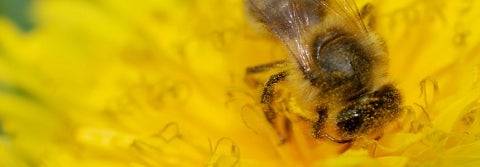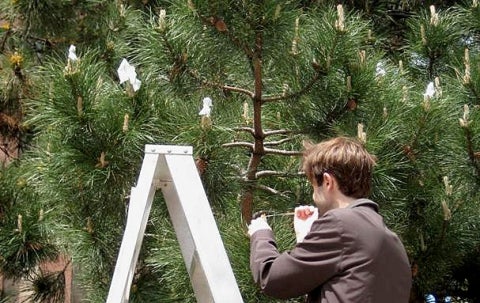Note: Yale School of the Environment (YSE) was formerly known as the Yale School of Forestry & Environmental Studies (F&ES). News articles and events posted prior to July 1, 2020 refer to the School's name at that time.

The first time police used pollen to solve a crime was in Austria in 1959. A forensic scientist studying the mud on a murder suspect’s boot found what turned out to be a 20-million-year-old pollen grain from a hickory tree. That species no longer grew in Austria then. But investigators were able to locate a Miocene sediment outcrop on the Danube River, from which such a pollen grain could have become recycled into the environment.
In the right setting, you can get spore grains from ferns that are fairly unaltered back to 470 million years ago and pollen from seed plants back 375 million years.
“We know you killed him,” they told the murder suspect, in the best police procedural fashion, “and we know where.” Then they took him to the outcrop. The suspect was so unnerved that he led them straight to the victim’s grave.
Pollen analysis is still surprisingly rare in U.S. courtrooms, though such cases have made it commonplace in some other countries. Even in the “CSI” era, Americans tend not to think about it much, other than as a cause of hay fever. Certainly no one grows up wanting to be a pollen scientist. Even experts in the field have a curious tendency to explain that they came to pollen only by accident and somehow got hooked. It’s as if they fear that outsiders might otherwise think them congenitally dull.
Pollen analysis is still surprisingly rare in U.S. courtrooms, though such cases have made it commonplace in some other countries. Even in the “CSI” era, Americans tend not to think about it much, other than as a cause of hay fever. Certainly no one grows up wanting to be a pollen scientist. Even experts in the field have a curious tendency to explain that they came to pollen only by accident and somehow got hooked. It’s as if they fear that outsiders might otherwise think them congenitally dull.
But for an impressive, if less sensational, variety of purposes other than forensics, pollen analysis has become a standard tool: Government agencies analyze the pollen content of fake Viagra and other prescription drugs to determine where they came from. Museums use pollen to authenticate paintings by master artists. Oil companies study fossil pollen to locate hydrocarbon deposits. Archaeologists study pollen to learn how ancient human communities used plants, and even the seasons at which they occupied a particular site. And paleobotanists study pollen evidence to reconstruct former environments, thousands or even millions of years into the past.
As scientific evidence, pollen has the advantage of being widely distributed, produced in vast quantities (researchers talk about the “pollen rain”), relatively easy for an expert to sort by species and extraordinarily resistant to decay.
The science of interpreting this evidence iscalled palynology, from the Greek meaning “the study of scattered dust.” Paul Sears, who later led a pioneering conservation program at Yale, popularized that name in the 1940s. He preferred it to pollenology, or pollen analysis, because this branch of science also encompasses spores, cysts and other microscopic residues of ferns, fungi, mosses, algae and even some animals.
As scientific evidence, pollen has the advantage of being widely distributed, produced in vast quantities (researchers talk about the “pollen rain”), relatively easy for an expert to sort by species and extraordinarily resistant to decay.
The science of interpreting this evidence iscalled palynology, from the Greek meaning “the study of scattered dust.” Paul Sears, who later led a pioneering conservation program at Yale, popularized that name in the 1940s. He preferred it to pollenology, or pollen analysis, because this branch of science also encompasses spores, cysts and other microscopic residues of ferns, fungi, mosses, algae and even some animals.
 Andrew Leslie is an F&ES postdoctoral fellow in paleobotany.
Andrew Leslie is an F&ES postdoctoral fellow in paleobotany.
Actual pollen is merely the best-known subject of study, and the most spectacular. Under a microscope, the individual grains of pollen from different species can look like soccer balls, sponges, padded cushions, coffee beans, or burr balls from the sweetgum tree. Their surfaces are covered with intricate geometric patterns—all spikes, warts and reticulations. Ernst Haeckel’s drawings of radiolarians come to mind. So do Buckminster Fuller’s buckyballs.
Pollen has a sturdy, cuticular outer wall, called the exine, and a delicate cellulose inner wall, the intine. Both serve to protect the sperm nucleus on the sometimes harrowing trip by way of a bat’s nose or a honeybee’s hind end, from the male anther to the female stigma. (The spikes and other surface ornaments help the pollen hang on. But other kinds of pollen have wing-like structures for riding on the wind.) The intine soon decays. The exine not only survives this trip, but if buried quickly, can last almost forever, preserved in the fossil record.
These structures “are very resistant to most biological forms of attack,” says Andrew Leslie, an F&ES postdoctoral fellow in paleobotany. “In the right setting, you can get spore grains from ferns that are fairly unaltered back to 470 million years ago and pollen from seed plants back 375 million years.”
Pollen has a sturdy, cuticular outer wall, called the exine, and a delicate cellulose inner wall, the intine. Both serve to protect the sperm nucleus on the sometimes harrowing trip by way of a bat’s nose or a honeybee’s hind end, from the male anther to the female stigma. (The spikes and other surface ornaments help the pollen hang on. But other kinds of pollen have wing-like structures for riding on the wind.) The intine soon decays. The exine not only survives this trip, but if buried quickly, can last almost forever, preserved in the fossil record.
These structures “are very resistant to most biological forms of attack,” says Andrew Leslie, an F&ES postdoctoral fellow in paleobotany. “In the right setting, you can get spore grains from ferns that are fairly unaltered back to 470 million years ago and pollen from seed plants back 375 million years.”
 Andrew Leslie collecting pollen samples.
Andrew Leslie collecting pollen samples.
Leslie estimates that a medium-sized black pine can produce 10 billion pollen spores, mostly released over the course of a single week each year. The combination of abundance and durability has made pollen an important tool for understanding how plant communities change over long periods of time. The standard technique is to drill into a study site and extract a stratigraphic core, giving the researcher a sort of layer-cake look into the past. Archaeologists also sometimes scrape away the vertical surface of a dig to get a clean profile, then remove soil samples every few inches, working from the bottom to the top to avoid contamination by falling dirt.
Back in the laboratory, each sample goes through repeated hydrochloric acid baths, which destroy everything except the almost immortal exine. The palynologist then puts the material on a microscope slide to determine how many species are present (worldwide almost a half-million species make pollen) and calculate the proportion of different species. That makes it possible to describe how the world looked in different time periods.
A recent study in Science, for instance, used pollen cores to demonstrate that extinction of Australia’s giant marsupials and other megafauna 40,000 years ago triggered the shift away from mixed rainforest habitat. Another study in Science examined the pollen record for southern Greenland and found that a conifer forest grew there during a period of natural warming 400,000 years ago.
What studying pollen gives scientists, in other words, is the means to do what the poet William Blake once imagined:
Back in the laboratory, each sample goes through repeated hydrochloric acid baths, which destroy everything except the almost immortal exine. The palynologist then puts the material on a microscope slide to determine how many species are present (worldwide almost a half-million species make pollen) and calculate the proportion of different species. That makes it possible to describe how the world looked in different time periods.
A recent study in Science, for instance, used pollen cores to demonstrate that extinction of Australia’s giant marsupials and other megafauna 40,000 years ago triggered the shift away from mixed rainforest habitat. Another study in Science examined the pollen record for southern Greenland and found that a conifer forest grew there during a period of natural warming 400,000 years ago.
What studying pollen gives scientists, in other words, is the means to do what the poet William Blake once imagined:
To see a world in a grain of sand,
And a heaven in a wild flower,
Hold infinity in the palm of your hand,
And eternity in an hour.
Published
January 1, 2000